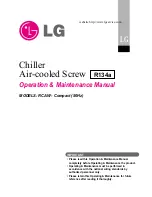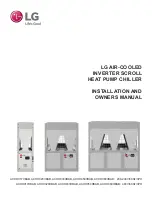
IOM 1206-7 • TRAILBLAZER
™
MODEL AGZ CHILLERS
12 www.DaikinApplied.com
I
nsTallaTIon
and
a
pplICaTIon
I
nformaTIon
Chilled Water Pump
It is important that the chilled water pumps be wired to, and
controlled by, the chiller’s microprocessor. When equipped
with optional dual pump output, the chiller controller has the
capability to selectively send the signal to a pump relay (by
others) to start pump A or B or automatically alternate pump
selection and also has standby operation capability. The
controller will energize the pump whenever at least one circuit
on the chiller is enabled to run, whether there is a call for
cooling or not. This helps ensure proper unit start-up sequence.
he pump will also be turned on when the water temperature
goes below the Freeze Setpoint for longer than a specified time
to help prevent evaporator freeze-up. Connection points are
shown in the Field Wiring Diagram beginning on
page 35
.
CAUTION
Adding glycol or draining the system is the recommended
method of freeze protection. If the chiller does not have
the ability to control the pumps and the water system is
not drained in temperatures below freezing, catastrophic
evaporator failure may occur.
Failure to allow pump control by the chiller may cause the
following problems:
1. If any device other than the chiller attempts to start the
chiller without first starting the pump, the chiller will lock
out on the No Flow alarm and require manual reset.
2. If the chiller evaporator water temperature drops below
the “Freeze setpoint” the chiller will attempt to start the
water pumps to avoid evaporator freeze. If the chiller
does not have the ability to start the pumps, the chiller
will alarm due to lack of water flow.
3. If the chiller does not have the ability to control the
pumps and the water system is not to be drained in
temperatures below freezing or contain glycol, the chiller
may be subject to catastrophic evaporator failure due to
freezing. The freeze rating of the evaporator is based on
the evaporator heater and pump operation. The external
brazed plate heater or shell and tube immersion heater
itself may not be able to properly protect the evaporator
from freezing without circulation of water.
Flow Switch
All chillers require a chilled water flow switch to check that
there is adequate water flow through the evaporator ant to shut
the unit down if there isn’t. There are two options for meeting
this requirement.
1.
A factory-mounted thermal dispersion flow switch.
2.
A “paddle” type flow switch is available from Daikin
Applied for field mounting and wiring. Wire from switch
terminals Y and R to the unit control panel terminals
shown on the field wiring diagrams,
page 35
and
page
36
. Mount the flow switch in the leaving water line to
shut down the unit when water flow is interrupted. A flow
switch is an equipment protection control and should
never be used to cycle a unit.
Installation should be per manufacturer’s instructions included
with the switch. Flow switches should be calibrated to shut off
the unit when operated below the minimum listed flow rate for
the unit as listed on
page 33
.
There is also a set of normally closed contacts on the switch
that can be used for an indicator light or an alarm to indicate
when a “no flow” condition exists. Freeze protect any flow
switch that is installed outdoors. Differential pressure switches
are not recommended for outdoor installation. They can freeze
and not indicate a no-flow conditions.
Glycol Solutions
The use of a glycol/water mixture in the evaporator to prevent
freezing will reduce system capacity and efficiency, as well
as increase pressure drop. The system capacity, required
glycol solution flow rate, and pressure drop with glycol may be
calculated using the following formulas and tables.
Glycol Flow Rate = Capacity Tons X Flow Correction Factor
(gpm)
0.00429 x ΔT
1 . Capacity
- Multiply the capacity based on water by the
Capacity correction factor from
Table 3
or
Table 4
.
2 . Flow
- Multiply the water evaporator flow by the Flow
correction factor from
Table 3
or
Table 4
to determine
the increased evaporator flow due to glycol. If the flow is
unknown, it can be calculated from the above equation.
3 . Pressure drop
- Multiply the water pressure drop from
Table 11
by Pressure Drop correction factor from
Table
3
or
Table 4
. High concentrations of propylene glycol at
low temperatures may cause unacceptably high pressure
drops.
4 . Power
- Multiply the water system power by Power
correction factor from
Table 3
or
Table 4
.
Содержание AGZ030E
Страница 4: ......















































